41 The Diversification of Mitsui Bussan

Mitsui Bussan in the 1920s
During World War I, Japan’s economy experienced an unprecedented boom as exports surged. Taking advantage of this opportunity, numerous trading companies were established, but many of them went bankrupt and disappeared between the post-World War I period and the 1920s. In the case of Mitsui Bussan, after rapid growth during the war, it suffered large losses at several branches during the postwar recession and the 1920 panic, but was able to cover them due to the substantial reserves it had accumulated previously. In the 1920s, the company increased its domestic trade ratio by pursuing a policy of expanding into regional markets within Japan and achieved stable, high earnings, mainly from coal and machinery.
In Mitsui Bussan’s case, a policy was adopted to maintain an almost constant dividend rate regardless of performance, and to retain profits internally. In the 1920s, those internal reserves grew considerably, and the company made progress in a shift toward self-funding its trade finance.
While it depended on the period, both Mitsui Bank and Mitsui Mining, in addition to Mitsui Bussan, also maintained a stable dividend. It appears that Mitsui Gomei Kaisha also adopted a policy of allowing direct subsidiaries to retain earnings internally unless there was a specific need.
Changes in Mitsui Bussan’s Investment Strategy
In 1918, Mitsui Bussan reduced its conventional in-house insurance operations and established Taisho Marine and Fire Insurance as a separate outside company. In 1920, it spun off its cotton division to form Toyo Cotton. Both companies were important affiliates of Mitsui Bussan, but they were both also characterized by the externalization of some of Mitsui Bussan’s trading function.
In the mid-1920s, a shift appeared in Mitsui’s Bussan’s investment strategy. Traditionally, the company had rarely owned manufacturing subsidiaries, although it had invested in manufacturers and dispatched executives to secure exclusive sales rights and so on. During this period, however, it established several manufacturing-related subsidiaries. These included Sanki Engineering (1925; machinery installation and construction contracting); Toyo Babcock (1928; boiler manufacturing); Toyo Carrier (1930; air conditioning equipment); and Toyo Otis Elevator (1932). In 1928, it also brought Nippon Flour Mills (formerly part of Suzuki Shoten, which had gone bankrupt the previous year) under its control.
At the 1926 branch managers’ meeting, Yasukawa Yunosuke (→Fig. 41c), the executive director (at the time, the president of Mitsui Bussan was a member of the Mitsui family, and the executive director was the de facto top executive), stated that though the company had previously avoided tying up capital whenever possible, as a “measure to respond to the times,” they would henceforth invest in industrial and infrastructure projects within the limits of available financing.
Establishment of Toyo Rayon
The establishment of Toyo Rayon Co., Ltd. (now Toray) was representative of this investment strategy, and was promoted under the leadership of Yasukawa Yunosuke. The company was founded on January 12, 1926, as a subsidiary of Mitsui Bussan (Capitalized at 10 million yen. During a capital increase in 1933, it went partially public through a stock offering, but before that Mitsui Bussan owned the shares, excluding those held by the founding members). A factory was built on the shores of Lake Biwa in Shiga Prefecture, and in August 1927, the company succeeded in the spinning of viscose rayon yarn; sales to the market began at the end of that year. Toyo Rayon expanded its sales network in the Japanese and other Asian markets and its performance steadily grew.
Investment Trends in the 1930s
In the 1930s, as the global economy became increasingly defined by blocs, restrictions on Mitsui Bussan’s trade transactions increased. Under these circumstances, the company’s external investments surged. From 1934 onwards, going into the process of recovering from the Showa Depression, investments were made primarily in the expanding heavy chemical field, with the aim of securing new business opportunities; this led to an increase in the number of affiliate companies.
Apart from these external investments, investments in Mitsui Bussan’s own shipbuilding division (established in 1917 in Tama Bay, Okayama Prefecture) also increased after 1931. That division became an independent entity in 1937 as Tama Dockyard, Ltd., and in 1942 changed its name to Mitsui Shipbuilding & Engineering. In addition, the shipping division (a shipping department had been established in 1903) also expanded its fleet while upgrading to new diesel ships. In 1942, the shipping division went independent as Mitsui Steamship.
During the second Sino-Japanese War (from 1937 on), as wartime controls further restricted commercial activity, this investment activity grew even further. Mitsui Bussan increased its borrowing from banks to secure the necessary funds for these investments.

On the right is a proposal form from Mitsui Gomei Kaisha. The proposal submitted by Mitsui Bussan on September 26, 1925, was approved by Mitsui Gomei Kaisha on January 13 of the following year. Normally, their approval would be obtained within a few days of a proposal’s submission, but getting this proposal approved took more than three months.
On the left is a board meeting record of Mitsui Gomei Kaisha, documenting the approval of the abovementioned proposal. In addition to Mitsui Gomei Kaisha’s own proposals, important proposals from its subsidiaries, including Mitsui Bussan, Mitsui Mining, and Toshin Soko were submitted for deliberation at meetings of the Board (→39).Through these board meeting records, one can grasp the overall picture of the important decision-making processes within the Mitsui zaibatsu (excluding the financial divisions) from 1924 through 1940.

Rayon (artificial silk) is a type of synthetic fiber that has greater luster than raw silk and can be produced more cheaply. As a result, demand for rayon grew rapidly from the 1920s onward.

In the 1920s, he served as the top executive at Mitsui Bussan and led the establishment of Toyo Rayon. Known as “Razor Yasu” for his sharp mind, he was seen as a symbol of the zaibatsu’s profit-driven approach amid rising criticism of the zaibatsu during the Showa Depression, criticism which eventually forced him to resign.
